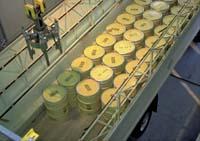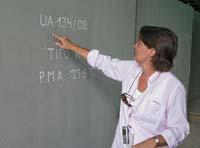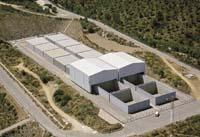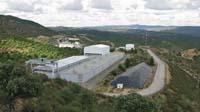2008/12/01
248. zenbakia

eu es fr en cat gl
Aparecerá un contenido traducido automáticamente. ¿Deseas continuar?
Un contenu traduit automatiquement apparaîtra. Voulez-vous continuer?
An automatically translated content item will be displayed. Do you want to continue?
Apareixerà un contingut traduït automàticament. Vols continuar?
Aparecerá un contido traducido automaticamente. ¿Desexas continuar?
Radioactive heritage at 300 years
Text created by automatic translator Elia and has not been subsequently revised by translators.
Elia Elhuyar
The Cabril is a plot of Enresa. It is located in Córdoba, in the mountains of Albarrana, between hills of oaks and pines. On your way it is not difficult to see deer and other wild animals. 12 kilometers before arrival, a sign indicates that it is a private road restricted access. There is no talk of radioactivity, but in it are stored medium and low grade nuclear waste of radioactivity. We have visited and taught us how they keep and control these waste.
Radioactive heritage at 300 years
01/12/2008 | Galarraga Aiestaran, Ana | Elhuyar Zientzia Komunikazioa

(Photo: Enresa)
We have travelled by car from the capital of Cordoba to El Cabril. We have taken a couple of hours to arrive and for those who do not know the way, it is not at all easy to arrive, since in the mountain is "lost". The environment presents a quite wild aspect, so when approaching the facilities of Enresa are remarkable. The buildings are new and have a light white color.
The director of El Cabril, Carlos Pérez Estévez, and the head of communication, Marta Arroyo Abad, await us. They have welcomed us with kindness and led us to a room to watch a video presentation. Here are some explanations. They tell us that the facilities began to be built in 1990 and that since 1992 it collects radioactive waste.
Specifically, in El Cabril medium and low level of radioactivity waste is stored from 800 radioactive facilities (hospitals, industries, research centers) distributed by Spain and eight Spanish nuclear power stations. The fuel used in the power plants, for its part, has a high level of radioactivity and, for the moment, is stored in the inactivation pond of each nuclear power plant.
Therefore, from nuclear power plants only the material used in operations is sent, such as gloves, rags, filters, resins, sludge, etc. All radioactive waste generated in hospitals and research centers are medium-low radioactivity: dressing gowns, gloves, syringes... Finally, the residues generated in the industries are also within this level of radioactivity.
Controlled risks Controlled risks

Radioactive waste reaches El Cabril in special trucks.
Enresa enresa
These waste comes to El Cabril in trucks. The number of trucks arriving per year is about 300, and many of them are concerned about the accidents that can occur during transport. When asking Director Pérez, he answers: "During all these years that we have been working there has been no accident."
There have been no earthquakes, but some of the inhabitants of neighboring villages and ecological groups are also concerned. In fact, radioactive waste is collected in the existing facilities at present in surface, being subsequently buried. For materials to stop being radioactive, three hundred years will be necessary. What would happen to an earthquake? The director also fully responds with certainty: "The facilities are prepared to withstand an earthquake of magnitude 8 on the Ritcher scale." In addition, all waste is stored solidified, so no leaks of gases or liquids can be produced.
To know first hand where and how they are stored and what security measures they take, Arroyo invites us to visit its facilities. In this way, we went with him to the control room. The room is full of computers from which all waste conditioning and storage operations are directed. All operations are fully automated, that is, in the conditioning system and in the warehouse there are no personnel, everything is done from the control room. This allows the staff to have no contact with the radioactive residue.
Conditioning and storage

From the control room, all waste conditioning and storage operations are directed.
A. A. Galarraga Galarraga
This waste reaches El Cabril in specially designed trucks. Antonio López, responsible for the conditioning and storage operations, explains that the material that comes in the trucks can arrive, depending on whether it is adapted or not. For example, gums, clothes, etc. arrive without adapting, wrapped in containers. These are compacted. Thus, the 90 cm long containers weighing about 100 kg make them 30 cm at a pressure of 270 bar.
Other materials, such as pieces of nuclear power plants, filters, etc. They already arrive adapted, that is, prepared with mortar. These containers are deposited directly in containers and compacted in the same containers.
The containers are cubes of 2 m of side that produce in the own Cabril with concrete of higher quality. In each of them enter 18 containers and once filled inject mortar to immobilize the content. Arroyo explained to us that they have containers in place for 20 hours to "harden the concrete well" and then store them.
The Cabril has 28 concrete storage structures on two concrete platforms. The north platform consists of 16 complete structures. Therefore, the containers are currently being kept on the south platform. To carry the containers from the conditioning facility to the structure, a large crane is used which is directed from the control room.

Marta Arroyo, responsible for communication of El Cabril, taught us first hand a concrete container. The waste is stored in this type of container.
A. A. Galarraga Galarraga
The structures are in filling phase with a mobile cover that prevents the entry of rainwater. As they fill the structures, they carry the mobile cover to the next structure, closing the structure filled with a concrete slab of half a meter thick. Finally, the closed structure is waterproofed with a synthetic cover.
Once the period of exploitation of El Cabril is finished, it will proceed to its total covering alternating draining and impermeable materials. Then you will proceed to the esplanation with earth and by planting autochthonous plants will be in harmony with the environment. From that moment on and for 300 years a control and surveillance program will be launched.
300 years, 3 centuries
The radioactive material stored in El Cabril will be buried inside the concrete barriers. The first barrier is the container, the next the container, the storage structure and finally the layers and the floor that will cover everything. In total there is a concrete of 10 meters thick and a waterproof cover of several meters between the radioactive waste and the natural environment. Objective: to avoid contact of water with radioactive waste.

Currently the containers are being kept on the south platform. As the structures of the platform are filled with the containers are being closed.
Enresa enresa
However, in the design of the control and surveillance system, it has been taken into account that a drop of water may reach the radioactive material. To verify its existence, a network of infiltration control under storage platforms has been built. Marta Arroyo has moved us to one of these galleries and has taught us the tubes and the container that would have collected the filtered water.
Each structure has a pipe hole by which it would be obtained if the water was filtered. Therefore, they would easily know what structure the problem is. Then, they should remove the lid and repair the cracks. Once asked what they would do with filtered water, Arroyo has answered us that they would check if it has radioactivity and if it were so they would treat it. They would use it to make concrete and store it as other materials. In this way, one of the main conditions of the installation would be guaranteed: absence of radioactive discharges.
He has not answered us, however, how they will ensure that someone is in charge of controlling him for about 300 years. It is the time that radioactive waste takes to stabilize. In fact, the period of semi-disintegration of the isotopes of the residues with a degree of medium and low radiation is 30 years maximum, which means that at 30 years its level of radiation has decreased by half. After ten periods of this type, that is, after 300 years, the degree of radiation of the waste will be similar to that of the environment.
Waste with very low radiation level

Under the platforms a network of infiltration control has been built. It is prepared to control for 300 years that water does not filter or come into contact with waste.
A. A. Galarraga Galarraga
But before, the warehouses of El Cabril must be filled. If you continue with current technology, it is expected to be around 30 years old. Meanwhile, a waste warehouse with very low radiation is also being prepared.
In 1998 and 2001 two Andalusian steel mills, and in 2003 two other Sestao and Gijón, accidentally generated a lot of waste with very low radiation. They took them to El Cabril and there they have them on their surface, covered by a waterproof awning. For proper conservation, a structure of 30.000 m 3 capacity has already been built and three new ones have been planned.

The Cabril has a lot of waste with very low degree of radiation, covered by a waterproof hopper (in the image, right). They have just built a warehouse for correct storage.
(Photo: A. A. Galarraga)
In addition to the residues produced accidentally, these structures will include those generated in the radioactive and nuclear facilities and in the dismantling of the power plants. All these residues have the same characteristic: their degree of radioactivity is very low and their volume is very high. Stored in these warehouses in preparation, radioactivity will be lost without contaminating the environment and people.
Both aspects are the subject of a thorough follow-up in El Cabril. Being all automated, the staff has no contact with the waste. However, they perform the usual measurements, for example, when we have left the visit to the conditioning facility, we have passed through an apparatus that measures radioactivity. The hands are placed and, next to a beep, appears on the screen: Garbi. That is, clean.
The environmental control is done by taking intermediate samples of air, water and ecosystem (vegetation, food, fish, etc. ). According to Arroyo, effects derived from the activity of the facilities have never been detected. This requires it.
Medium and low radioactivity waste. What are they?
Based on the definition of the Spanish Nuclear Security Council (CSN), the materials collected are defined as radioactive waste with intermediate activity. They do not produce heat; it is mainly formed by isotopes with a period of semi-decay less than 30 years, and they have few alpha wave emitters (alpha radiation has very little capacity to cross the matter, a sheet of paper may remain).

Measure the degree of radiation from a hospital's waste.
(Photo: Enresa)
Within the residues of medium and low radioactivity are also included the residues of very low radioactivity, which by its physicochemical characteristics do not require to be deposited in concrete rooms.
In Spain a total of 700 m 3 or 1,500 tons of this type of waste per year and 160 tons of fuel used in nuclear power plants are generated.
Background History History
Enresa was born in 1984, a public body responsible for radioactive waste in Spain. The company itself does not generate nuclear waste, but has the mission of collecting, conditioning and storing the medium and low level nuclear waste generated in Spain.
However, the director of El Cabril, Carlos Pérez, explained that nuclear waste was already stored in El Cabril. In this area is the Beta mine. Uranium was extracted from that mine in the 1940s, and its owner was the Nuclear Energy Board of the time (Nuclear Energy Board, JEN). Years later, mining activity was abandoned, but it was used by JEN from 1961 to store the nuclear waste that was generated in Spain at the time.

Beta mine.
(Photo: Enresa)
It should be noted that in the 1960s many countries dreamed of building a nuclear bomb. Spain was among those countries. According to a document published by the CIA in January of this year, Franco had an ambitious nuclear project that sought to build, for example, a plant for the enrichment of uranium with the aim of making a bomb. The first nuclear power plants were then built: José Cabrera in 1968 and Santa María de Garoña in 1971. All these activities, of course, generated radioactive waste.
With the creation of Enresa in 1984, the Government of Spain transfers to this company the property of the existing waste in El Cabril, as well as the responsibility of preserving the waste that would be generated to date and from then on. It was then that the current installations were designed, according to the director, "international models".
Now the Beta mine is empty. With the commissioning of the new facilities, all existing material was collected and, once properly conditioned, it was stored on the north platform.
Waste problems with a high degree of radiation
Although there is some concern for residues with medium and low levels of radiation, this is not at all equal to that generated by high radiation. The last study carried out by the Eurobarometer on the subject reveals that this is precisely the greatest obstacle to the acceptance of nuclear energy. In fact, four out of ten against nuclear power would change their mind if a safe and sustainable solution were found for these nuclear waste.
This is the third survey on nuclear waste carried out by the Eurobarometer. The previous two were carried out in 1998 and 2001, and since 2005 the proportion of those who bet on nuclear energy has increased. It seems that the increase in energy consumption, the oil crisis and climate change have contributed to strengthening the commitment to diversification of energy sources, in which more and more are considered useful for nuclear energy. Thus, in the last study, 44% of respondents are in favor of nuclear energy and 45% against it.
In any case, there is still no suitable solution for residues with a high degree of radiation. And that generates concern: 93% of respondents believe it is really urgent to find a solution now without leaving that work to the next generations. But they are not optimistic: seven in ten say there is no safe way to store waste. In the case of choosing one of the alternatives, it is committed to a deep geological storage.
That is, the best or most acceptable of all options is to bury in depth. But where? In Finland, underground storage has already begun, but in other countries it has not yet been decided where to do so. And it's not easy, who wants to have nuclear waste under his feet?
Galarraga de Aiestaran, Ana
Services Services Services
248 248 248
2008 2008 2008 2008 2008
Description Description Description Description
029 029 029
Energy; Environment
Article Article Article
Services Services Services














